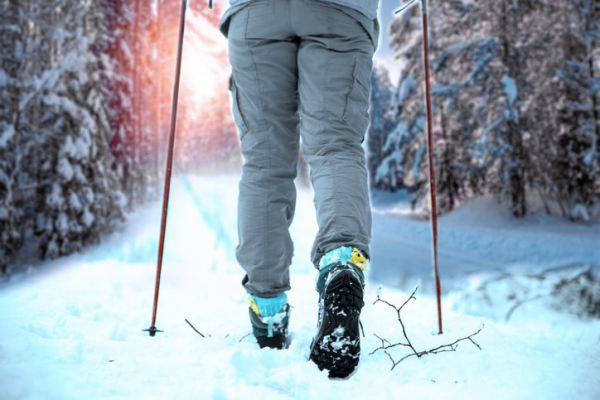
Winter hiking: Magical or miserable?

By midwinter, our urge to hibernate can start to feel constricting instead of cozy. What better antidote to being cooped up indoors than a bracing hike in the crisp air outdoors?
Winter backdrops are stark, serene, and often stunning. With fewer people on the trail, you may spot more creatures out and about. And it’s a prime opportunity to engage with the seasons and our living planet around us, says Dr. Stuart Harris, chief of the Division of Wilderness Medicine at Massachusetts General Hospital. But a multi-mile trek through rough, frosty terrain is far different than warm-weather hiking, requiring consideration of health and safety, he notes. Here’s what to know before you go.
Winter hiking: Safety first
“The challenge of hiking when environmental conditions are a little more demanding requires a very different approach on a winter’s day as opposed to a summer’s day,” Dr. Harris says. “But it gives us a chance to be immersed in the living world around us. It’s our ancient heritage.”
A safety-first attitude is especially important if you’re hiking with others of different ages and abilities — say, with older relatives or small children. It’s crucial to have both the right gear and the right mindset to make it enjoyable and safe for all involved.
Planning and preparation for winter hikes
Prepare well beforehand, especially if you’re mixing participants with vastly different fitness levels. Plan your route carefully, rather than just winging it.
People at the extremes of age — the very old or very young — are most vulnerable to frigid temperatures, and cold-weather hiking can be more taxing on the body. “Winter conditions can be more demanding on the heart than a perfectly-temperatured day,” Harris says. “Be mindful of the physical capabilities of everyone in your group, letting this define where you go. It’s supposed to be fun, not a punishing activity.”
Before setting out:
- Know how far, high, and remote you’re going to go, Dr. Harris advises, and check the forecast for the area where you’ll be hiking, taking wind chill and speed into account. Particularly at higher altitudes, weather can change from hour to hour, so keep abreast of expectations for temperature levels and any precipitation.
- Know if you’ll have access to emergency cell coverage if anything goes wrong.
- Always share plans with someone not on your hike, including expected route and time you’ll return. Fill out trailhead registers so park rangers will also know you’re on the trail in case of emergency.
What to wear for winter hikes
Prepare for extremes of cold, wind, snow, and even rain to avoid frostbite or hypothermia, when body temperature drops dangerously low.
- Dress in layers. Several thin layers of clothing are better than one thick one. Peel off a layer when you’re feeling warm in high sun and add it back when in shadow. Ideally, wear a base layer made from wicking fabric that can draw sweat away from the skin, followed by layers that insulate and protect from wind and moisture. “As they say, there’s no bad weather, just inappropriate clothing,” Dr. Harris says. “Take a day pack or rucksack and throw a couple of extra thermal layers in. I never head out for any hike without some ability to change as the weather changes.”
- Protect head, hands, and feet. Wear a wool hat, a thick pair of gloves or mittens, and two pairs of socks. Bring dry spares. Your boots should be waterproof and have a rugged, grippy sole.
- Wear sunscreen. You can still get a sunburn in winter, especially in places where the sun’s glare reflects off the snow.
Carry essentials to help ensure safety
- Extra food and water. Hiking in the cold takes serious energy, burning many more calories than the same activity done in summer temperatures. Pack nutrient-dense snacks such as trail mix and granola bars, which often combine nuts, dried fruit, and oats to provide needed protein, fat, and calories. It’s also key to stay hydrated to keep your core temperature normal. Bonus points for bringing a warm drink in a thermos to warm your core if you’re chilled.
- First aid kit. Bandages for slips or scrapes on the trail and heat-reflecting blankets to cover someone showing signs of hypothermia are wise. Even in above-freezing temperatures, hypothermia is possible. Watch for signs such as shivering, confusion, exhaustion, or slurring words, and seek immediate help.
- Light source. Time your hike so you’re not on the trail in darkness. But bring a light source in case you get stuck. “A flashlight or headlamp is pretty darn useful if you’re hiking anywhere near the edges of daylight,” Harris says.
- Phone, map, compass, or GPS device plus extra batteries. Don’t rely on your phone for GPS tracking, but fully charge it in case you need to reach someone quickly. “Make sure that you have the technology and skill set to be able to navigate on- or off-trail,” Harris says, “and that you have a means of outside communication, especially if you’re in a large, mixed group.”
About the Author

Maureen Salamon, Executive Editor, Harvard Women's Health Watch
Maureen Salamon is executive editor of Harvard Women’s Health Watch. She began her career as a newspaper reporter and later covered health and medicine for a wide variety of websites, magazines, and hospitals. Her work has … See Full Bio View all posts by Maureen Salamon

No-cost, low-cost, and bigger splurges for climate-conscious gifts

Looking for gifts to give or donate this year? Climate-conscious gifts come in many guises. They may directly support our environment, for example, or aim to reduce fossil fuel use and electronic, textile, and food waste. Or they might offer enjoyable, creative ways to connect, reuse, and recycle — and possibly even regift.
“Our purchases and choices impact our climate and planet,” notes Dr. Wynne Armand, a physician and associate director of the Massachusetts General Hospital Center for the Environment and Health. Small steps like these do help, she says, even when the complex issues of climate change leading to health-compromising pollution, extreme weather, and a stressed planet feel so large and overwhelming.
“Unquestionably, we need bold, strong leaders to seek policy changes that address these problems at a systems level. But, as individuals we can make a difference through small steps,” says Dr. Armand. “Our choices help drive cultural and market shifts that hopefully push our neighbors, businesses, and policy leaders in the right direction.”
Four climate-conscious principles for gifting
- Channel the 5 Rs.Refuse, reduce, reuse, repurpose, and only then recycle. Say no to excess. Comic sections from print newspapers or beautiful images from last year’s calendars or magazines make great envelopes and gift wrap. If you’re choosing clothes, consider buying upcycled clothing or at resale shops, as appropriate.
- Beware of greenwashing. Eco-consciousness is big business, and the benefits of what you buy may be questionable. If you have a small lawn that needs infrequent maintenance, says Dr. Armand, keeping a trusty (albeit gas-fueled) mower could be a better choice for the planet than buying an electric mower, when factoring in upstream costs of natural resources and the carbon footprint required to manufacture and ship the new — and toss out the not-so-old. (Alternatively, maybe it’s time to replant that lawn with wildflowers and vegetables?)
- Skip what’s not needed. A new backpack crafted from water bottles? Another sweater to add to a closetful? If there’s no apparent need, think twice about purchases.
- Double down on experiences and connection. Think concert tickets, museum passes, or energetic options like rock-climbing gym passes and outdoor skills classes. “Gifts of experience are great, especially for people who already have all they need. If you buy for two or try a skills swap you also get to enjoy that time together,” says Dr. Armand.
25 climate-conscious gifts
Below are 25 suggestions for climate-conscious giving intended to work with many budgets.
Small but mighty climate-conscious gifts
1. Soft, warm sweaters, thick socks, or puffer vests can help people turn down the heat, saving energy resources and money.
2. Rechargeable batteries reduce materials and packaging waste.
3. An electric kettle, induction hot plate, or toaster oven can help limit indoor pollutants from gas stoves.
4. Perfectly Good Food: A Totally Achievable Zero Waste Approach to Home Cooking aims to pare back food waste and is available online.
5. Shop local artisans and craft fairs rather than buying online.
6. Plants brighten any room and help scrub the air: choose easy-care varieties, such as succulents, colorful coleus, and some herbs.
7. Protect the natural world: birds, bees, and other insects could use your help. Consider a small bird feeder that attaches to a window, a bee house, gardening tools, or seeds for a pollinator garden of colorful flowers.
8. Donate to national or worldwide climate or environmental organizations, local green spaces, and local conservation groups.
9. Gift green bonds for companies that support renewable energy — do your research, though, because greenwashing can be an issue.
10. Secret gifter-giftee swaps with large groups save sanity and throttle back waste.
Bigger splurges on climate-conscious gifts
11. When appliances reach the end of useful life, consider replacing gas stoves, water heaters, washers, dryers, and similar items with electric versions.
12. Plan a week of nearby tours and events with friends or family instead of flights and faraway travel.
13. Gift clothes and tools to enjoy the natural world: for example, warm, waterproof clothing and hiking boots, cross-country skis or skates, good binoculars for bird-watching.
14. Composters (or a weekly composting service subscription) recycle food scraps and organic waste into soil-enriching “black gold.”
15. Electric bikes may be a boon if they reduce reliance on vehicles using fossil fuels.
16. Help fund energy-efficient heat pumps or renewable solar energy.
17. Substantial donations and sustaining donor gifts to climate-conscious organizations can help in many ways.
No-cost climate-conscious gifts
18. Offer to gather information on big-ticket items in the big splurges section, including state and federal rebates and 0% loans for heat pumps, energy-efficient furnaces, solar panels, and energy-efficient appliances.
19. Teach a skill one-on-one, such as home repair, skating, chess, training for a mud run, knitting, cooking, orienteering, or gardening, or organize skills swaps with friends.
20. Gift the human power needed to replant portions of a lawn with vegetables or pollinator plants, or make a rain garden (note: automatic download) to help divert storm water.
21. Combine a no-cost reminder of the environmental benefits of no-mow May and leave the leaves campaigns with an offer to help peel back these layers come spring.
22. Friends often want to gift one another — costly generosity that can prompt last-minute candle-buying. As an alternative, gather a small group of friends for a clothing, accessories, and candle swap of new, never-took-the-price-tag-off, nearly new, and well-loved items.
23. Offer a DIY nature or bird walk for two. Try the free Pl@ntnet and Merlin apps if you can’t tell a pin oak from a petunia or a robin from a California condor.
24. If you buy for a ton of people, buy in bulk and figure out how to parcel it out in more sustainable packaging.
25. Make dinner, fudge, or another treat with friends — not completely free, but always a great way to gather your community.
About the Author

Francesca Coltrera, Editor, Harvard Health Blog
Francesca Coltrera is editor of the Harvard Health Blog, and a senior content writer and editor for Harvard Health Publishing. She is an award-winning medical writer and co-author of Living Through Breast Cancer and The Breast … See Full Bio View all posts by Francesca Coltrera
About the Reviewer

Howard E. LeWine, MD, Chief Medical Editor, Harvard Health Publishing
Dr. Howard LeWine is a practicing internist at Brigham and Women’s Hospital in Boston, Chief Medical Editor at Harvard Health Publishing, and editor in chief of Harvard Men’s Health Watch. See Full Bio View all posts by Howard E. LeWine, MD